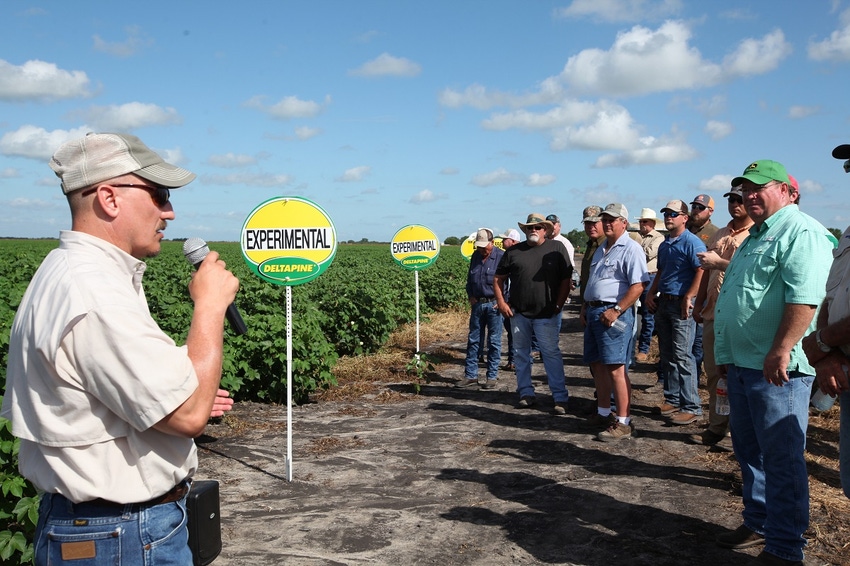August 1, 2016

More than 100 farmers attending the recent 4th annual Paul Freund Farms Field Day in Needville, Texas, had a chance to see and hear about top-performing Deltapine cotton varieties for the Texas Upper Gulf Coast region, as well as cotton technologies like Bollgard II XtendFlex and developing cotton technologies Bollgard 3.
The Monsanto field day also showcased Roundup Ready 2 Xtend soybean and DEKALB grain sorghum trials, a bare-ground weed control demonstration, and a DEKALB corn hybrid discussion.
“There’s a lot of work done on the farm here that is of particular interest to farmers in this area, from weed management plots to testing new germplasm for cotton, corn, grain sorghum and soybeans,” said Tom Owen, an area business manager with Monsanto. “In particular, there is a lot of focus on the Roundup Ready Xtend Crop System. With the label pending for over-the-top use of dicamba, growers are anxious to hear more about this technology that many expect will be an important tool for their farms.”
One new Bollgard II XtendFlex cotton variety garnering a lot of attention at the field day was DP 1646 B2XF, a full-season product that has shown outstanding yield and quality potential in many areas of the Cotton Belt, including the Texas Gulf Coast.
“There’s a lot of excitement around DP 1646 B2XF, and we’ve got a good bit of this variety out this year,” said Owen. “We think it’s going to be a good fit in a lot of areas, including this region. It really travels well.”
Jim Bosch, East Texas technical agronomist for Monsanto, told growers that DP 1646 B2XF has performed well in tests so far this season, showing strong emergence and good vigor characteristics. Compared to other full-season, high-yield potential varieties, “You’re going to get a much longer staple length out of DP 1646 B2XF,” said Bosch. “It’s been running from a 37 to a 40 staple length, so it’s got a premium length will that add a few pennies to your loan price. That’s a differential that is pretty important to farmers.”
MORE VARIETIES
Other cotton varieties Bosch described as being well-suited to the Upper Gulf Coast region include:
DP 1518 B2XF
This is an early-season product that, when planted on highly productive land with good irrigation, can be pushed into a longer growing and fruiting period. “I wouldn’t put it on tougher dryland because it’s going to act like an early-season product and give up some yield,” said Bosch. “But if you do have irrigation and are willing to push this along, you can make it a mid- to full-season variety, and we’ve seen some really top yields out of it.” The variety is easy to manage from a plant growth regulator (PGR) perspective, has good seed size and comes out of the ground well. It also has bacterial blight resistance. “It has top-end yield potential where we push it, and it’s very competitive with the better full-season varieties,” said Bosch. “From a fiber quality standpoint, it can run a 35 to 36 staple length and can have good micronaire in the 4.2 to 4.5 range.”
DP 1522 B2XF
This broad-acre product has good performance potential across a range of agronomic field conditions, according to Bosch. “It responds well to irrigation and also is strong on dryland,” he said. “It’s a tall plant that isn’t quite as responsive to PGRs as DP 1518 B2XF, so you’ll want to get in a little earlier and hold the height down, triggering that reproductive phase.” Seed size is very large, and the variety shows good emergence, said Bosch. Its fiber quality tends to be similar to DP 1518 B2XF, running a 35 to 36 staple length. “It has good, solid uniformity, and you can get a lot of yield potential out of it,” he said.
DP 1553 B2XF
This full-season variety has high yield potential, especially in high-yield environments, and also excellent fiber quality. The variety is comparable to DP 1646 B2XF in terms of height, but is about 3 to 5 days later-maturing. The variety is a vigorous plant classified as moderately responsive to PGR, “which means you’ll want to start your PGR applications earlier and possibly use higher rates on soils that tend to grow a tall plant,” said Bosch.
Bosch noted that the Bollgard II XtendFlex technology launched in cotton varieties last year is the direction Monsanto will take as it develops and releases cotton varieties going forward. Bollgard II XtendFlex is the only cotton technology with tolerance to three herbicides—dicamba, glyphosate and glufosinate. In 2016, growers can use Roundup brand glyphosate-only agricultural herbicides and Liberty herbicide (glufosinate), while over-the-top use of dicamba is still pending approval from the Environmental Protection Agency.
Beginning in 2018, pending approvals, farmers will also have access to varieties with Bollgard 3, which will enhance the insect protection in earlier Bollgard products. This next-generation technology will provide season-long protection with multiple modes of action against key lepidopteran pests in cotton fields.
“That is a move to protect the traits and not let resistance develop,” said Bosch.
You May Also Like




